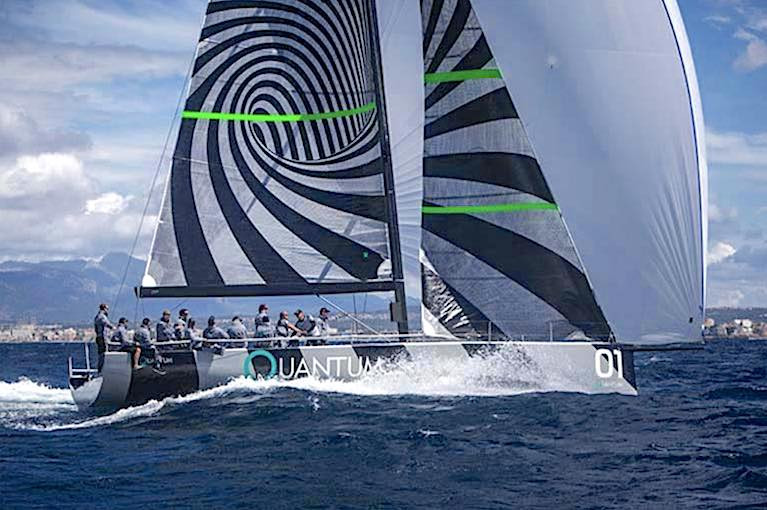Whether you are racing or cruising, the choice of the cloth that your spinnaker is made from is important for speed and longevity. Mark Mansfield from Quantum Sails goes through the main options and suppliers of spinnaker cloth. Quantum Sails can provide spinnakers in all manufacturers' materials, depending on an owner's choice.
Racing options
The vast majority of nylon downwind sails are made by 2 Suppliers. Contender from Holland produces the Superkote/Superlite range of PU impregnated nylons.
Bainbridge from the UK produces the PU Impregnated AirX range. Both are similar, but there are specific differences.
Contender Superkote/Superlight - Contenders Superkote/Superlite would be the most popular of racing nylons for all-round use. Available in 12 different weight ranges and 14 different colours, it covers a vast range of options. Superlite is generally for smaller boats of less than 30 feet. Superkote is the main Spinnaker range for boats over 30 foot.
Bainbridge AirX - Bainbridge is a Uk company and has been in the sailmaking and sailcloth production business since 1917 when they originally produced sails for large commercial sailing Ships. Now a top-level cloth manufacturer, their products have won Americas Cups, Round the World races and Olympics. Their AirX range has seven different weights and 12 different colours.
 Quantum A2 spinnaker running Superkote SK75 Photo: Quantum Sails
Quantum A2 spinnaker running Superkote SK75 Photo: Quantum Sails
So what's the difference?
Both AirX and Superkote are produced as light as possible and feature a highly resonated finish that adds both strength and water resistance to its exterior and interior ripstop material. The AirX range has more 'resination' than Superkote and so feels crispier than Superkote, even when used quite a bit. Superkote is less stiff, particularly diagonally.
For running spinnakers, Superkote is believed to be more flexible and less stiff in light and moderate conditions and so is likely the better all-round option. Less stiff means it bounces around less and possibly needs less trimming. However, In stronger air and particularly reaching when the sail is powered up, the lack of Diagonal movement in the Airx is an advantage.
Cost-wise AirX cloth is less expensive than Superkote, and the difference in a sail can be 10% to 15%.
 Gringo, the Dublin Bay A35 running downwind
Gringo, the Dublin Bay A35 running downwind
What cloth weight?
Most owners will be aware of the term .75 oz. and half oz. And might think that their sails weigh that figure. So for instance Contender, Superkote 75 would be the most popular weight in their range and is very popular for midrange yachts of around 35 foot. Superkote 75 weighs .93 of an Oz.
Weight range performance Superlite and Superkote
 Weight range performance Superlite and Superkote Table via Quantum Sails
Weight range performance Superlite and Superkote Table via Quantum Sails
Weight options
If an owner of a mid-range racing boat was changing just one spinnaker, it more than likely would be their all-round runner. In a Symmetric, this would be their S2. In an Asymmetric boat, like a J109, this would be their A2. As a result, they likely would go for a cloth weight that would do them from 5 knots right up to 20/25 knots. If it were Contender Superkote, then that likely would be the SK75. If it were AirX, then that likely would be AirX 600.
However, this wind range (5 to 25 knots) is quite large so for performance in lighter air, it would be better to have a lighter cloth, so Superkote SK60 would be a very nice option from 5 to 18 knots or so, then Superkote 90 above that. Effectively the Sk90 would be an A4 (heavy running Asymmetric spinnaker). We have just sold a pair of Spinnakers to a top J109 in Dublin, who would have previously just gone for a standard all-round runner SK 75, and now will have a heavy and a light runner. Also using an All-round Spinnaker in 20 to 25 knots runs the risk of tearing, particularly when broaching or even launching the spinnaker.
A heavy Runner, or a Reacher in a heavy cloth, will likely last a very long time due to the cloth weight and the fact that they would not be used that often each season. On the other hand, the Light runner wears out quickly as it is used 80% of the time and often is carried over its range. Once a resonated cloth like SK75 or Airx 600 starts to get soft or retains water easily, it likely is not as quick or efficient. Also, as it is not as slippery, it takes longer to launch, and notably in an Asymmetric, takes a lot longer to set coming out of a gybe as the cloth clings to itself during the gybe. The cloth, once it loses its finish, becomes a bit porous and a small amount of performance is lost due to the wind passing through the cloth. Competitive racing boats will change their all-round light air spinnaker every year or two and the benefits of a new sail become very clear. A main or a Headsail will show its age and speed loss; however, a spinnaker will still look OK when it becomes slow.
Cruising spinnakers
For Cruising sailors the time that a spinnaker is changed if often when the previous one explodes and is not worth the big expense of a repair. Often the cloth has broken down, or the stitching on the corners has started to deteriorate.
Cruising Spinnaker cloth is normally less resonated and so will not be as crispy. The material itself will likely be heavier and the threads, as a result, are denser. The extra weight is not normally as important, and extra threads make it less resistant to tearing. When not set it often will sink down to the end of the sail bag as without the extra coating, it takes up less room in the bag.
Bainbridge and Contender again lead the pack with their Products, Bainbridge has their MP range and Contender have their Nylite range. Both options would be less expensive than their Racing Counterparts (Superkote and AirX). Of the two MP from Bainbridge would again be less expensive than Nylite.
Other options for cruising spinnakers
Cruising sailors who only want one spinnaker aboard recently look at the cruising range of Asymmetric sails that can be set on a top-down furler. This can be either a Code 0 or an Asymmetric Cruising spinnaker. The ease of launching and retrieving is the main advantage over a conventional spinnaker. Code 0's are now coming in cable-less forms allowing the halyard to be eased when the wind in further aft to give the sail more power and then when the wind is more forward, the halyard is kept firm to give a flatter entry. Quantum sails have a range of Cabled and Cable less A sails and Code 0's for cruising sailors. I will do another article shortly specifically on Code 0's.
Quantum would be delighted to quote for any new racing or cruising Spinnakers (or upwind sails) which can be specified in any suitable Material. Contact Mark Mansfield at [email protected] or by phone at 00 353 87 250 6838


























































